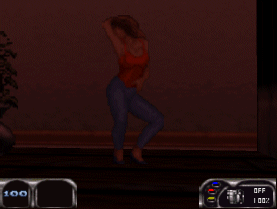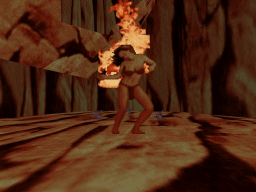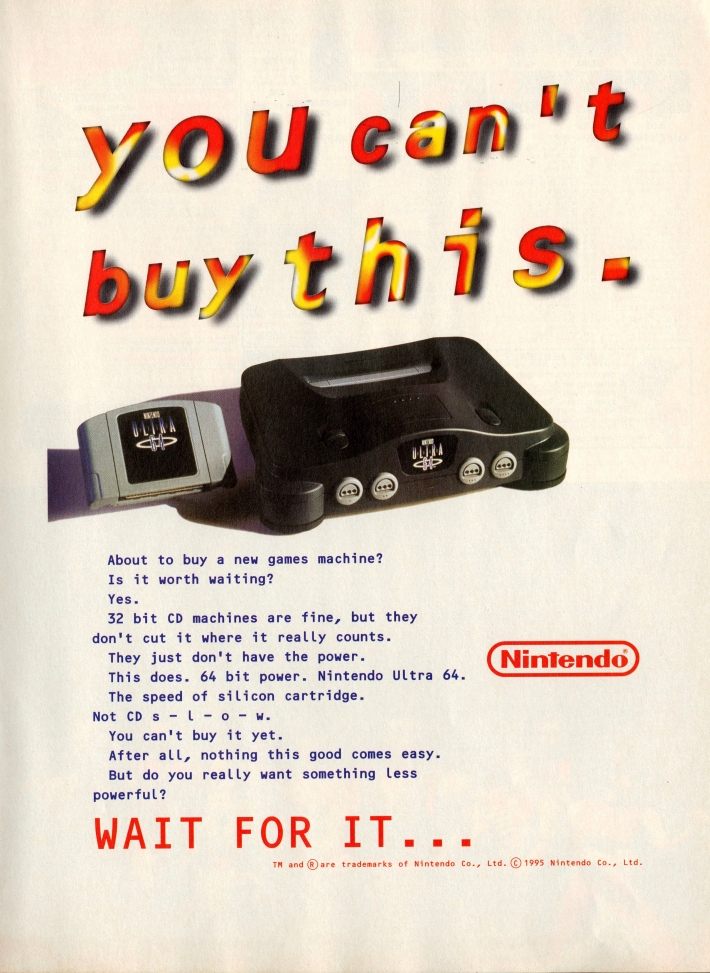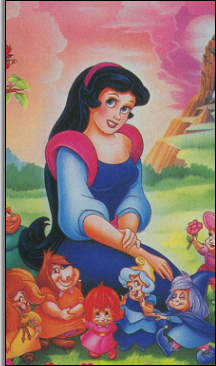Duke Nukem 64 (Prototype, Nintendo 64)
Scott Miller, founder of Apogee Software, doing business as 3D Realms, stated that the mission of Duke Nukem 3D was to break the cookie-cutter mold of first-person shooters. “DOOM clones,” as they were then called, had flooded the market after former business partner id Software’s 1993 cultural juggernaut took the computer gaming world by force. DOOM had players ripping around corridor mazes of a Martian space base in a descent down to the depths of Hell as a nameless, generic marine known simply by fans as “DOOMguy.”
DOOM designer John Romero explained years later, “There was never a name for the DOOM marine because it’s supposed to be you” (link).
The game’s real character derives more from the foreboding atmosphere, the soundtrack’s pumping metal licks, the more muted moody music, and the general break-neck pace of the gun-toting action.
Acting more than mere distractions would, the amble interactivity gives players a sense of immersion that was unparalleled at the time of its release.
Duke Nukem 3D changed all of that in 1996, upping the ante considerably. It replaced the dark hellishness of distant Mars with an equally frightening, not-so-distant downtown Los Angeles. Rather than the threat of fantastical monsters, inhuman zombies, and biblical demons, Duke Nukem 3D appeared to have been invaded by politically incorrect stereotypes: the ever aggressive Los Angeles Police Department who devolve into the literal epithet of pigs, and more abstractly portrayed brown-skinned “aliens” who take over the urban wasteland and make the remaining light-skinned women theirs. Whether you subscribe to University of Missouri-Kansas City Professor Anthony Sze-Fai Shiu’s latter theory of the game’s white nationalistic, xenophobic, “anti-miscegenationist longings,” or view his argument as academic gymnastics of Olympic proportions, it nevertheless speaks to the software’s potential to provoke above and beyond what DOOM had first wrought (link).
That, in part, is a direct result of allowing players to enter a credible-but-caricatured simulation of the everyday real world. While DOOM‘s sterile environments are largely foreign, enclosed, barren, and static, Duke’s non-linear natural habitat is familiar, destructible, interactive, and alive. He can flip light switches on and off, run a movie projector, play billiards, tip strippers with wads of folded bills, admire himself in mirrors, gulp from water fountains, fire hydrants, or even toilets, relieve himself in urinals, track in dog dirt, check payphones, ride subway cars, get picked up by cranes, sing karaoke, talk into a drive-thru speaker, squish enemies by closing doorways on them, stick his finger into wall outlets senselessly, and generally destroy anything and everything that he encounters. If Duke opens a public restroom stall, he might catch an adversary plopped on the can–blasting before flushing, he can then trample over the emaciated remains and leave behind bloody tracks on the carpeted floor.
The indistinguishable industrial military buildings of DOOM collapse to become a seedy metropolis of diverse neighborhoods, each mining a certain attraction for all its filthiness: a red light district, a self-referential movie set back lot, an erotic sushi bar, a nauseating fast food slop joint that sells Jolly Meals to kids, a sleazy porn production studio, a corrupt police station connected to an inept courthouse, a sexed up Disneyland theme park. The final showdown of Episode 3 takes place on the most hallowed of American ground, where the Christian Sabbath is spent for many: a football field in a professional stadium. The outcome of the game is, for once, a matter of life and death.
The plentiful maps are not a mismatch of themes–they often jointly feed into each other, picking up where the last left off, creating a greater sense of identity to the twisted macrocosm in which Duke lives and breathes.

The foul-mouthed attitude spilled right over into the game engine’s code. Allen H. Blum III, one of Duke’s most proficient map makers, forgot to delete a handful of his leftover messages from the final release. At one time, they would have displayed on the screen based upon the current frame rate, becoming increasingly ruder as things slowed down, from “FUCKIN PISS ANT” and “YOU SUCK DONKEY” to “YOUR MOTHER IS A WHORE” (link).
Players can become better immersed in this parallel universe by gazing up and down at its dirtiness with the use of a mouse, rather than being locked into a fixed forward-looking perspective as in DOOM, all the while experiencing scripted events happening around them, such as an exploding room or a whole building going up in smoke.
Duke Nukem 3D‘s BUILD Engine, which was remarkably enough written by a teenage Ken Silverman while on sabbatical from Brown University, also allows for more instinctive architecture in the form of sloped surfaces, movable sectors like swinging doors, and tricks to cast the illusion of room-over-rooms and underwater areas (link). The user-friendly editor has a WYSIWYG (“What You See Is What You Get”) component for developers to move about a map and modify it in real-time via a 3D Edit Mode, making the process of designing levels that more seamless and personal. In a 1997 boot magazine interview, John Carmack, the programming perfectionist behind DOOM‘s engine, named Silverman as “the most talented” person working in 3D games (link).
If Brian Bosworth, the flamboyant ex-linebacker-turned-B-movie-star who once tested positive for steroids, and the 6′ 5″ Rocky IV villain Dolph Lundgren had a love child together, that baby would be Duke Nukem. When asked who’d he like to see play the character in a movie, Scott Miller chose another footballer, former Raiders defensive end Howie Long (link). He described Duke as a composite of “John Wayne, Clint Eastwood, and Batman” (link). (Image source: Amazon.com)
At its rugged heart, Duke Nukem 3D encourages free-form exploration, from crouching in rat-infested air vents to jet packing above pollution-scarred skyscrapers and swimming in sewers of filth beneath the city. Duke’s wild inventory is an extension of the open-ended strategy, with a shrink ray being able to miniaturize his enemies–and himself–and a holographic decoy that can be projected to momentarily distract would-be dangers. Toss a Pipebomb into a crowded room and duck out before hitting the detonator, lure a group into a narrow hallway lit up like Christmas morning with red-beamed Laser Tripbombs, or use the Freezethrower to turn a threat into crushed ice shards–Duke does more than kill, he does so with style.
Every hero needs a theme song, but Duke’s came from an unlikely source: a frustrated, 10-year accountant for the Internal Revenue Service. Lee Jackson quit his hellish IRS job and was brought on board at Apogee to work tech support, which meant learning all of the company’s games. With his true passion lying in music, he took extra care to study their soundtracks, which was mostly done by an outside contractor, Bobby Prince, the man who would go on to compose DOOM. Prince had written the medley that played at the beginning of all of Apogee’s software. Jackson tried making his own rendition, and the result impressed his bosses so much that it immediately replaced Prince’s. He had a new role now as a musical composer, which led him to create the anthem for Duke Nukem 3D, known as “Grabbag.” Jackson explained the name in an interview: “You see, ‘Grabbag’ was actually an experiment, inspired by a day-long session of listening to heavy metal CDs. I tried pasting together what I heard as the basic bits that defined a heavy metal song, like the scales, mode changes, rhythmic hits, and so on. I had to stick with General MIDI sounds, which made the job a lot harder. Eventually, I came up with a short tune that I considered a grab bag of heavy metal elements” (link, link). The harmonial compilation seems fitting for Duke’s exaggerated collage-like, postmodern persona.
But perhaps most striking of all, instead of a muzzled, twitching, wallet-size portrait trapped in the head-up display, Duke Nukem commands a larger-than-life presence, cursing profusely and spouting several situation-appropriate audio quips along the way. His dialogue lines chisel out a distinct personality for the character as the hyperbolic embodiment of the red-blooded, gun-worshiping, steroid-built, hedonistic, chauvinistic, egomaniacal, hypermasculinized anti-hero who mimics and reflects American cinematic pop escapism, the audience for which film critic Roger Ebert once described as “bubblebrained adolescents of all ages” (link).
Duke Nukem 3D is served up as a roast of not only the growing gaming genre but of the larger American culture of celebrity, vice, and violence, gleefully wallowing in every lurid moment of it.
The game goes so far as to subvert the sordid news of the day, with competing billboard signs showing O.J. Simpson’s racially divisive murder trial verdict of “Innocent,” followed by a bloody question mark, and another exclaiming “Guilty,” the famous white Ford Bronco looping on a strip bar’s television set, and the “if it doesn’t fit, you must acquit” black glove in a police evidence room. A well-hidden, booby-trapped apartment of the Unabomber is placed squarely above a comedy club. Then there’s the “Valdeez-2” ocean liner, carrying oil as cargo in a level with the none too inspiring name of Derelict, the secret “Postal Rifle Association” meeting place at a post office, and a butcher’s backroom with “USAD-graded,” farm-raised SESOS, Spanish for “beef brains,” only with a picture of a baby seal taped over the poster and a bloody club hanging nearby alongside a “catch of the net” squeaking dolphin, in a disparagement of the country’s ineffectual food regulatory agencies and the crude and uncaring state of the meat industry.
(Image source: Duke.GTInteractive.com/Archive.org)
Duke Nukem 3D‘s marketing campaign even got in on the lampooning by publishing a fake political party website called “Nukem ’96” to poke fun at the presidential contest that year among Bill Clinton, Bob Dole, and Ross Perot.
But not everyone saw the game as a playful send-up.
In a 1999 interview with IGN For Men, actor Bruce Campbell had this to say about 3D Realms lifting some of Duke’s one-liners from the Evil Dead film trilogy in which he starred: “Well, they’re rip-off artists. Let them get their own damn material. It’s called hiring a writer. They’re blatantly ripping it off and if I was any kind of litigious guy they would’ve gotten a phone call by now. It’s depressing and I think it’s wrong” (link).
The May 1997 edition of Penthouse caused a small uproar for photographing “Pet of the Month” Andrea Kurtz crouching over a toilet visibly urinating. “While we have depicted this act before,” the magazine’s founder, Bob Guccione, said a month later, “this particular photo generated an enthusiastic vote of confidence from our readers.” Other than Claudia Bajmlova on the front cover, none of the May pictorials show up anywhere in the promotional Duke Nukem 3D level. Instead, the four models who do appear, posing in 13 cropped still images, were pulled from back issues dating all the way back to 1988: Lydia Schone (January 1995), Kelly Jackson (October 1990), Tiffany Stevens (July 1989), and Joanne Szmereta (February 1988).
Then, in May 1997, Duke’s spoofing of Hollywood’s smuttiness became muddled when he teamed up with Penthouse magazine for a downloadable level called Duke Nukem’s Penthouse Paradise. With the help of an advertising agency, the officially sanctioned add-on was made freely available on Penthouse‘s website. In an oddly worded press release, Holly Newman, vice president of marketing for Duke’s publisher, GT Interactive Software, announced, “It is only fitting that a character with Duke’s panache and style collaborates with the modern women of Penthouse magazine.” The wire went on to say that “He never had a pet as a kid, but that’s all changing now as 3D Realms’s Duke Nukem finally gets a little something to love–a Penthouse Pet!”
One of the only instances of unobstructed nakedness is actually Duke’s own, when he sits his bare behind on a copier machine. His cheeky tattoo is an ode to Lani Minella, the veteran voice actress who recorded some of the lines in Duke Nukem 3D and persuaded a San Diego radio station director named Jon St. John to audition over the phone for the lead role (link).
Duke Nukem 3D never shows any overt nudity of its female residents, unless you count the four cobalt blue mammary glands of the extraterrestrial Queen boss; the exotic dancers wear nipple tassels, and besides a couple of porcelain geisha statues, which the player can interact with by opening the tops of their kimonos, and a few other inanimate scenery pieces like blurry girly magazines, anatomical charts, or broken down theme park animatronic figures, the rest is sideboob innuendo that looks positively neutered compared to what passes in modern games.
But the real-life digitized “Penthouse Pets” now bared it all, thus blurring the line between parody and pornography. It was difficult to see that such details were being inserted in the pursuit of tonality–grittiness and not gimmicks.
A community Duke Nukem fansite at the time called Dukeworld was given permission to distribute the publisher-approved, fan-developed supplement a couple of years later beginning in February 1999. By October, the file had been downloaded over 332,000 times, making it far and away the most popular hosted user-map (link, link).
Some played through the short level and forgot about it just as quickly, while others complained that it was a cheap ploy to appeal to pubescent players who had been “turned on” to Duke Nukem 3D for reasons other than gameplay (link).
This was not a new charge leveled at the FPS, as the perceived sexual objectification of non-playable women characters had been an issue for some critics since the game’s initial debut. In a mixed staff review of Duke Nukem 3D, Computer Games Magazine described the inclusion of strippers and prostitutes for “no logical reason,” while all other humans are presumably “dead or captured,” as “just crass and sleazy” and “cheap soft porn,” calling the “‘women as sex objects’ theme… truly offensive,” and warning that “feminists of all genders are bound to be offended.”
While the “Babes” may act as the motivating force in the hackneyed plot, they still only exist to shake it for Duke, breed with aliens, or otherwise suffer unless the player takes pity and initiates mercy killings. Duke Nukem 3D presents a negative consequence to ending their innocent lives, in the form of more enemies spawning, but in a game where bodies mount up like snowdrifts, the magazine pointed out that this doesn’t seem like much of a deterrent (link).
3D Realms Co-Owner George Broussard responded to criticism like this by saying that the scantily clad depictions of women were meant to stay true to the squalid setting of the game, adding that he knew they would also “spark controversy and sell more copies,” which he claimed was the best kind of game design. As for them being caught in the crossfire and exploding, he argued that was in keeping with the rest of Duke Nukem 3D‘s penchant for destruction–anything less would have been, in his words, “lame” (link).
After hearing these candid comments, it might seem strange for Duke’s next partnership to be with an historically squeaky-clean company like Nintendo, but that’s exactly what happened in November 1997 when English developers Eurocom were contracted to make Duke Nukem 64.

The Microwave Expander dings to let you know when it’s done.
More of a remix than a straight port, the Nintendo 64 title has re-arranged layouts, including additional secret areas, across 30 levels from the original Duke Nukem 3D and the Plutonium PAK expansion. This version also introduces five new weapons (Grenade Launcher, Dual-Wielding Sub-Machine Guns, Microwave Expander, Missile Launcher, Plasma Cannon), two-player cooperative, and four-player Dukematch with optional Dukebots on four exclusive multiplayer maps.
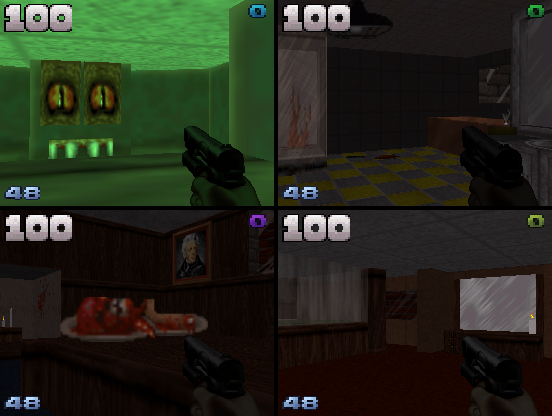
If the thought of staying at an old, dilapidated mansion in the middle of a thunderstorm doesn’t creep you out, the growling monster lurking within the walls should do the trick. Wandering through certain areas of the dark and eerie Castle Dukenstein, the first of the Nintendo 64-only Dukematch stages, will trigger the beast to materialize elsewhere on the map: in the library, the foyer, or the dining room. “Spot” doesn’t pose any threat, other than a cheap scare out of your opponent. The piercing eyes and fangs are actually textures taken from the Cycloid Emperor model (picnums 3647, 3650, 3656).
While the game doesn’t skimp on features, it did leave out the skimpy outfits. In a complete reversal, Duke’s mouth was washed out, and several of the spicier elements were toned down or removed completely.
 |
 |
|
|
|
 |
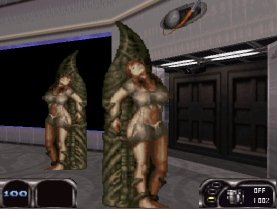 |
|
|
|
 |
 |
|
|
|
For instance, the aforementioned paralyzed women imprisoned in slimy cocoons, who once begged Duke to end their pain, in a disturbing homage to Aliens, now could be safely rescued, and not slain, which seemed like a far more appropriate gesture from the cocksure lady lover. (According to a 1999 interview with GameSpot, this was something that Scott Miller agreed with and was hoping to push further in Duke Nukem Forever, despite being “met with heavy resistance within the company” for the thought that it would take away from the realism and the player’s own free will [link].)
The Nintendo 64 instruction manual details the change, urging players to “free them before it’s too late.”
The forced Nintendo 64 alterations made for a contentious development cycle, with the dependably boisterous Broussard delivering these fighting words: “You know, if they flat out force us to take out the strippers from the game, then everyone else in the world is going to know that we’re totally against Nintendo and gamers shouldn’t buy their stuff. At least then everyone will have their opinions heard. You know, it’s like OK, Duke sucks, and here’s why, it’s Nintendo’s fault” (link).
In a masterful PR dodge, when asked about the game’s censorship, GT Interactive Senior Communications Manager Dan Harnett told IGN that, although there “will be no nudity, no religious references, no swearing, and no killing of women or dogs,” he ensured that the “Babes… will sport bigger busts in tighter fitting clothing” (link).
|
|
|
The enlarged pixel proportions of the female sprites were debatable, but their new, almost surgically-implanted mom jeans did look rather uncomfortable to slide into. One question that the interviewer failed to ask: Are marketers not born with souls, or do they gradually exit the body through the natural course of their lives?
|
|
|
Coming from a Catholic home with crucifixes peering out at me at every corner, like the watchful electronic eyes of the security cameras in Duke’s digital landscapes, and taught most of my young life by the Handmaids of the Sacred Heart, and warned not to do anything that I wouldn’t want them to read on the front page of the newspaper, Duke Nukem 64 marked a froward milestone in my game-playing career: It was the first Mature-rated cartridge that I ever convinced my parents to buy me when I turned 13. At that ripe old age, Duke was the height of hilarity, and his game was on the cutting edge. The censorship turned out to be a blessing in disguise for me, if it weren’t for the cut content–like the monk swinging from the chapel’s rafters in Death Row (a tribute to an earlier Apogee FPS called Rise of the Triad: Dark War) and the gyrating go-go girls–I would have never been allowed to bring Duke home in the first place.
Like many ’90s youngsters, I had sneaked away to watch Schwarzenegger-type movies with friends, so I recognized what the game was tapping into, and now that I’m older, I can better conceptualize it: the extreme male power fantasy, inconsequential mass murder with all the moral weight of a feather–a one-man’s just war, where death is a setup to a punchline, and taking a breather for a flash of the female form or any excuse to film on location in a strip joint is nigh obligatory. In my adolescent years, I grinned at the gruesomeness and repeated the bone-cracking wisecracks with as much giddiness as Duke Nukem.
Replaying Duke Nukem 3D today feels like sitting down to one of the bloody, schlocky motion pictures it’s partially modeled after, similar to witnessing a stone-faced Arnold slaughter a small army in his pursuit to rescue a kidnapped Alyssa Milano in 1985’s Commando–the entertainment value can come from a place of ironic appreciation that you would normally expect from a black comedy. There’s a deadening charm to the absurdity and total lack of self-awareness that helps to defuse the over-the-top vulgar brutality. With every flying limb and blood splatter comes a wink and a nod.
 |
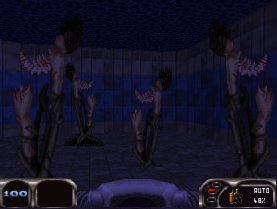 |
|
|
|
Peering through the fog of Tinsel Town glamour and disorienting nostalgia, however, it’s hard not to see how even the watered down Nintendo 64 version of Duke Nukem 3D contains sections of highly questionable taste that don’t appear to communicate or skewer anything, except maybe Nintendo of America’s inexplicable game content guidelines at the time. In Hotel Hell, for example, the once empty swimming pool that had a Baby Ruth candy bar submerged at the bottom, in a harmless salute to Caddyshack, now for an unknown reason is occupied by drowned bodies of mutilated women, their abdomens gutted and spines exposed so as to not reveal any disdainful outer flesh.
The sad commentary of how graphic violence is more acceptable than nudity or sex in American society could be a whole article in its own right.
While acknowledging the eldritch shock value veneer, which, again, for the most part coolly takes its cues straight from the popcorn media, where life is expendable and the human body is exploitable, it is undeniable how Duke’s deeper core and campy play mechanics all come together. In spite of the now antiquated reliance on multicolor keycards and switch puzzles, and the outer space detour that is Episode 2, which feels like a regressive uprooting back to DOOM territory, the multipath maps remain challengingly complex and satisfying to venture, and I would even go so far as to call the expertly designed Hollywood Holocaust level the best start to any FPS to date.
There may have always been a blot on its escutcheon, but there is a reason why Duke Nukem 3D stood out in a sea of imitators: Pulling from the past while breaking new ground, crassly controversial but cleverly crafted, Duke dared to be different.
![]()
In an effort to try to gain more of an understanding about the developmental history of the Nintendo 64 adaptation, and the balancing act of sanitizing the conversion while still retaining Duke’s irreverent signature, I reached out to Nick Dry, a credited artist on Duke Nukem 64. When I caught up with him, he was just about to get the PC sandbox FPS Block N Load out the door.
Nick Dry’s mugshot on a wanted poster in the Nintendo 64 Freeway level’s L.A.R.D. police station.
Could you please begin by telling me what your contributions were on Duke Nukem 64?
So, many moons ago the Internet wasn’t as accessible as it is now, Eurocom functioned in a bubble. Back then, it was a small unit of very focused guys from that “bedroom developer” era making a living on kids games for Genesis and PlayStation. They got a good rep for bringing quality work in on time and on schedule.
I was hired initially as a concept artist who essentially got trained on the in-house tools. With my education, I was more a designer who had a knack for looking at the overall product, not just the granular components that go on behind the scenes. We all had one thing in common, and that was playing games.
Back then, lunchtimes were an hour of multiplayer LAN shenanigans like DOOM and Descent but also Duke. I was an utter bastard playing Duke; I’d totally outsmarted everyone.
Then, one day a producer asked if I’d like to be responsible for helping out porting Duke to the N64. “Of course!” In my naiveté, or just because of the way things worked, I didn’t get contracted as a designer, which in hindsight I should have!
So on Duke I did the following: designed new weapons, UI flow, the controller design, the level design, textures, writing/audio replacements, and balanced the entire game.

(Image source: RetroMags.com)
It’s interesting that you worked on the weapons. I was always curious why the back of the North American game box showed a screenshot of the Plasma Cannon sporting a yellow color much like the PC title’s Freezethrower. I suppose that was done to further differentiate it? What was the decision-making behind which weapons would be carried over and which would be replaced? Did 3D Realms have any input into the game’s changes?
I think it was because of the respect and approach we took with it all. 3D Realms did sign off stuff, but I can’t remember anything major that was a problem. In fact, they encouraged new ideas, and I think that was good because it did bring new stuff to the mix. The Plasma Cannon might have been a different ammo type? Not sure off the top of my head.
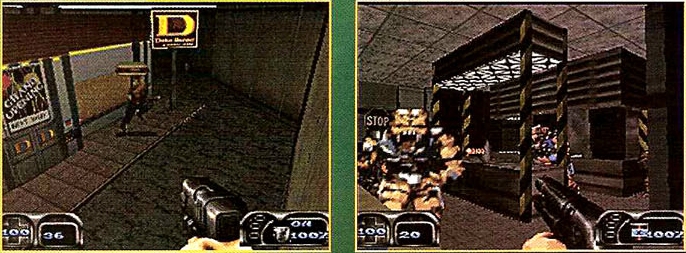
A preview version of the Nintendo 64 game shows the original computer weapon sprites. (Image source: RetroMags.com)
All weapons were re-rendered, or changed by the artist in 3D and then redone as sprites. All the SFX was rerecorded to bring their levels up, as the original ones were quite flat–different bit rate and quality of the .wavs, I think?
Back then, dual-wielding weapons was like the “in thing” with Hollywood action movies, so we got double SMGs, mostly ’cause they looked good and made Duke feel like a badass!
We needed to keep Duke’s default pistol, even though I tried to push for a Desert Eagle type–but this is where the ammo types came into play: one less weapon to worry about, but now the pistol has an additional bonus. The ammo types actually derived from a U.K. comic character by the name of Judge Dredd [and his gun] Lawgiver.
There are a couple of secret messages hidden in the game code. One refers to “Gas Grenades,” and another references “Rubber Bullets.” The Grenade Launcher didn’t have upgradable ammo in the released game, and the Pistol used Dum-dum Rounds. Were there going to be more alternate ammo types besides the aforementioned Dum-dum Rounds, the Exploding Shotgun Shells, and the Heatseeker Missiles?
Yeah, Gas Grenades and Rubber Bullets, we had them in and working, can’t rightly remember why they weren’t in release. Gas might have been a performance thing or a balancing thing or someone just wanted explosives.
Shame, as they were pretty fun, even better in deathmatch scenario.
There might have been a conversation about too many ammo types in general.
Besides causing more damage, did they have any other special effects, like the Heatseeker Missiles being able to track opponents? Were the Rubber Bullets designed for the SMGs?
Gas Grenades just left a toxic AOE [“Area of Effect”]. You’d fire one, [it would] hit a wall, and land on the floor. Anything that walked into it took damage over time. We did plan on certain NPCs getting buffed instead of poisoned, but I can’t remember if that was something we tried or wanted to try.
Rubber Bullets bounced off walls. They were to be fired from the Grenade Launcher, and I think the intention was to do small damage but to also stun a target, which just enabled players to control a fight.
(Image source: Nintendo Software Submissions Requirements handbook)
The Nintendo 64 port rather notoriously had some of the original computer game’s adult content removed. Was this censorship ordered by Nintendo or was it self-mandated by Eurocom?

The Society for the Preparation of Canine Hamburger building in Duke-Burger would have plainly violated Nintendo’s no “depictions of animal cruelty or torture” policy (Image source: N64.com)
So, this was Nintendo all the way. We knew Duke was a bit hardcore and back then Turok was the only other product that wasn’t “family friendly.” Throughout development, it was a continual thing with Nintendo of America, so stuff was always getting discussed. Nintendo sent us this document of “what was suitable,” etc. I seem to remember a particular line as a point of reference that used “Sherlock Holmes can have a pipe because that’s part of his costume,” but advocating alcohol/drugs/smoking was a non-goer, so was sex, and blood, etc. So begrudgingly, Duke’s cigar had to go.
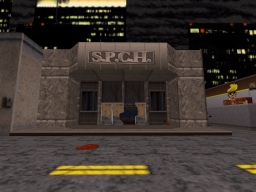 |
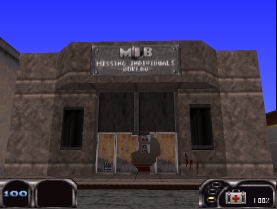 |
|
|
|
 |
 |
|
|
|
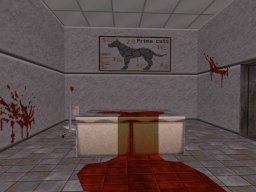 |
 |
|
|
|
So I went through everything in the game, like everything–graphics, audio, anything that was a warning bell and flagged it. As you can imagine, the audit for Duke ended up quite big!
 |
 |
|
|
|
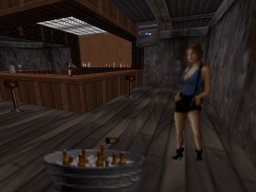 |
 |
|
|
|
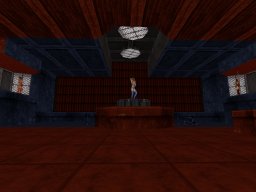 |
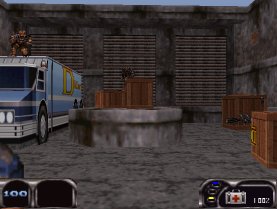 |
|
|
|
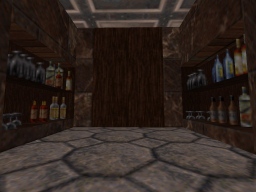 |
 |
|
|
|
 |
 |
|
|
|
|
|
|
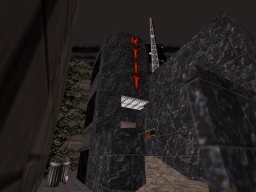 |
 |
|
|
|
 |
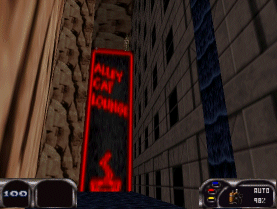 |
|
|
|
 |
 |
|
|
|
I brought up the subject of violence, but I never got a coherent answer from anyone, which always made me chuckle!
It was rumored that to compensate for the strippers in the game not showing as much skin, they were at one time going to wear long-sleeved shirts with raunchy sayings like “Eat me” or “Wear fur” (link). Can you share some insight on the visual evolution of how the female characters were going to be portrayed?
So, the challenge with Duke, for myself, was how do I change Duke enough from the PC game but still make it feel like Duke? I wanted fans of the PC to play this and enjoy a very similar experience. The strippers we could lose, but Duke was all about rescuing the damsels in distress. The bottom line from Nintendo was “cover them up” or get rid of them, but since Duke is a massive satirical parody, what could you do to have a similar impact that implied a suggestive undertone?
|
|
|
We just changed enough to get it signed off, that really was it, see how much we could push it until someone said “no.” I think it got to the point where we kind of got away with far more than I thought we would ever do.
We also had no female developers on the project, so I know in today’s marketplace it would be a different story, but then a game like Duke would be a harder thing to sell [today].
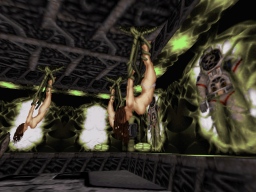 |
 |
|
|
|
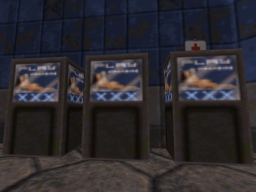 |
 |
|
|
|
Duke Nukem 64 arguably had a rawer, more brutal feel to it than the original Duke Nukem 3D. For example, in Red Light District, which was renamed to “Gun Crazy” in Duke Nukem 64, an adult video shop was converted into a gun and ammunition store. Even the female model on the cover of a nudie magazine had her body reshaped into a bullet. Was there a conscious push on Eurocom’s part to ramp up the game’s violence? If so, why?
 |
 |
|
|
|
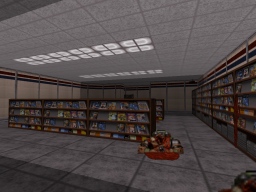 |
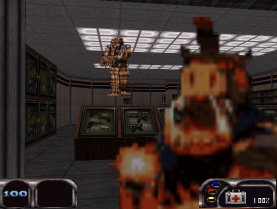 |
|
|
|
As stated previously, Nintendo’s stance on violence was a rather hazy area, plus if I had to lose the Red Light District, we had to chuck something else in that had just as much of an impact. I love the Western obsession with the gun, I loved Duke’s obsession with guns, it just felt right to swap the sexual overtones into another form, and the gun was just that.
Plus, I had to introduce to the player to new weapons so it made sense to have that shop.
 |
 |
|
|
|
 |
 |
|
|
|
Now the excessive violence became–and was–second nature. I think Duke can get away with it because he’s a parody, a cartoon of something that epitomizes a different culture or generation, but on paper he’s still an anomaly, whether or not it’s a suitable product or not, who knows… I’m sure there’s some jobsworth out there who spent more time writing about this sort of thing than attempting to make a bloody game themselves.

(Image source: Abandonware-Magazines.org)
A French magazine called PlayMag published an early Duke Nukem 64 screenshot in September 1997 that showed the movie theater marquee playing “Attack of the 50 Ft. Nukem.” This was ultimately changed to “Uranus Attacks” for the released game, with a flying saucer being projected on the cinema screen. The original Duke Nukem 3D used the name “Attack of the Bleached Blonde Biker Bimbos” and had a wiggling showgirl. This underwent its own transformation, as the movie posters at one point referred to the film as “Debbie Does Duke.” Do you recall why the “Attack of the 50 Ft. Nukem” title was changed, and if another animated movie ever played inside the theater?
I used to have the poster of Attack of the 50 Foot Woman on the wall in my house. I made a smaller version that found its way into Duke. For obvious reasons, the name was changed and it stayed like that for a couple of builds. When one of our artists changed the screen from the “dancing lady,” we wanted something else [to replace it] that looked good on the big screen, and we ended up doing the UFO.
 |
 |
|
|
|
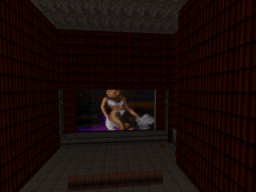 |
 |
|
|
|
It tied into the aliens’ invasion subplot–if you can call it that, a sort of foreshadowing of it all. Having a cheesy sci-fi B-movie posters and references all over the first level, etc.
“Debbie Does Duke” is a reference to an old porno that everyone seemed to have a copy of on VHS at one point.
|
|
|
There were two other elements noticeably left out of Duke Nukem 64: in-game music and mirrors. Was there a reason why they didn’t make it into the game?
Mirrors were another engine issue, for what they were they weren’t [worth] the hassle. I think they were quite expensive for the level budget so we just stripped them out. I think there was also a memory issue with the in-game music and the way the audio files were called in the initial load. I suspect a conversation went along the lines of “Duke says all of this stuff, you can either have that and no in-game music or you have in-game music and we cut Duke’s lines.” I think you can see what the answer was.

An earlier version of the Nintendo 64 title screen is seen in the instruction manual.
Do you remember anything that didn’t make it into the final game and was left on the cutting room floor?
Surprisingly, everything we did made it in–I think.
Getting the entire PC keyboard working on an N64 pad was “fun.” You could suggest that was a good compromise considering what we had to work with.
|
|
|
Duke’s lines, they all had to be redone–censored where applicable–so I had the chance of adding quite a few new ones, where I just nicked them from films I liked that kind of fit Duke’s world. Hearing those for the first time was great.
We had a fair few issues with BUILD–the engine 3D Realms used–and the way our engine worked, lifts and moving platforms mostly caused a few headaches. A couple of levels had to be reworked but nothing you’d notice.
Explosions weren’t kind to our frame rate, I seem to remember.
 |
 |
|
|
|
 |
 |
|
|
|
 |
 |
|
|
|
We did a lot of film references in the game that we changed enough to stop any repercussions, I remember producers sweating over those.
Other than that, we tried to give the Nintendo players an almost carbon copy but with a few extras. I actually think content-wise it’s the best version out there, and when you got your head around the controls, it was quite fun to play.
Three things I really liked:
The Grenade Launcher, such fun ricocheting off walls.
Different ammo types in general, speed running the game with the right ammo used on the right NPCs.
Hidden rooms! Those [players] that knew Duke inside out knew where they were, all we did was move them around in the same location. We never lost any, in fact, we added quite a lot more.
 |
 |
|
|
|
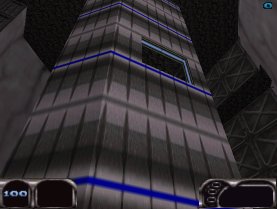 |
 |
|
|
|
I would definitely agree with you that the Nintendo 64 game is the most comprehensive version. There was just so much packed into that cartridge. I wanted to ask if anything didn’t make it, though, because I recall reading previews that said the multiplayer was going to have two-on-two team play, Capture the Flag, and another feature that went by the name of either “Scavenger Race” or “Meltdown Mode,” which GT Interactive described as “[pitting] players against one another in a run-and-gun race to the end of a level.” Were any of these actually planned?
I had to chat with another ex-colleague about this, as he worked on the multiplayer maps, and he seems to think that this might have been marketing for either the PlayStation version or something in relation to Zero Hour. It definitely wasn’t anything for Duke Nukem 64. Back then, it was just straight out deathmatch-type stuff but with levels that were much smaller setups.
(Image source: RetroMags.com)
The additional multiplayer modes were announced in early magazine previews of Duke Nukem 64 and even in the press release that GT Interactive put out during its launch week.
As for the press release, this is where the front of house, i.e. marketing, is spinning the game. Coming from a development background, you don’t get final say on copy. Maybe it was something discussed further up the food chain? I’d have remembered something like that. The fact that my colleague didn’t remember makes me believe the latter. Good research, though.
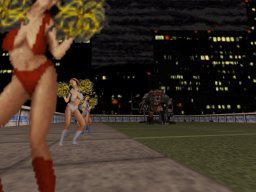 |
 |
|
|
|
What was the decision behind making the final Cycloid Emperor alien boss fully polygonal? Were there ever conversations about doing the same with any of the other characters?
Doing the final boss as a 3D model? I think it was a combination of a few things.
Initially, I think it was discussed to have all NPCs in 3D. I suspect [because of] a combination of events, primarily memory, we didn’t do it. You have to remember that writing an engine, on time, on schedule, would have required development time we didn’t have. I was a big advocate of keeping it “old school,” but at that time sprite-based games weren’t what publishers wanted; it was 3D or nothing. We were porting an established license, going too far down the 3D route could have had us so far removed that our target demographic might not have respected the changes and reviews may not [have said that the game had remained] faithful.
|
|
|
 |
 |
|
|
|
 |
 |
|
|
|
On the subject of hidden rooms, I noticed that, although some of the secret messages had disappeared, I remember one in particular was added, “Wots your beef speccy,” which always had me scratching my head. Was that some kind of an in-joke? For that matter, I wondered if “The Good Old Boys” Blues Brothers cover band were modeled after Eurocom employees.
|
|
|
“Wots your beef speccy” was a quote from an artist who always used to say it to one of the guys working on the project when he used to poke his nose into someone else’s work. Where it’s used in-game, it actually replaced “Dopefish,” which I think was changed because Nintendo said it’s a drug reference, but anyone who knows their old school first-person shooters knows it’s something much [different].

This preview screenshot reveals the original, unedited The Good Old Boys poster. (Image source: RetroMags.com)
Blues Brothers was one of my favorite films. I wanted the film poster in the game. I had to change it “enough” to get it in, which is why it ended up with the name change and [different] characters.
There are five unused crosshair graphics hidden in Duke Nukem 64’s game code. One looks like a pig, another is a chicken, and a couple are smiley faces. What purpose would they have served? Why were they scrapped?
The crosshairs are coder art. That’s definitely one of them making their time more fun testing the game.
And the question to end all others: If you have played Duke Nukem Forever, was it worth the wait?
Honestly, I never did. There was so much development hell–and too many cooks and all that. I felt like the character’s time had gone by to really do it justice… Additionally, my home PC rig back then wasn’t a beast to play the bloody thing. I watched a lot of YouTube videos, though, but, yet again, it just didn’t feel like Duke?
![]()
When a PAL prototype of Duke Nukem 64 surfaced online in April 2009, I had hoped to have a closer firsthand look into the game’s rocky relationship with Nintendo’s censors.
This is an NUS-8F16F-128M Nintendo 64 flash ROM development cartridge. In plain English, what does that all mean?
(Image source: OldGameMags.com)
Before the system was called the Nintendo 64, it went by the name Nintendo Ultra 64, and the acronym “NUS” remained stamped on all Nintendo 64 hardware and software afterwards.
The “8F16F” portion refers to the type of official Nintendo-manufactured circuit board inside of this cartridge, an NUS-8F16F-01. This is an older model that lacks the 256-kilobit static RAM that its successor, the NUS-8F16FB, had. There are eight flash memory sockets available on this board, and 16 megabits of data can be stored on each one.
If you recall your multiplication tables, you can probably guess what “128M” stands for–the board’s overall storage size, 128 megabits, which is equivalent to 16 megabytes. The released Duke Nukem 64 weighs in at 64 megabits, or 8 megabytes, meaning that this board can by right hold as much as twice that amount.
While on the subject of storage, Nintendo 64 development boards like this employ a kind of technology called flash memory, which itself is a type of EEPROM, or Electrically Erasable Programmable Read Only Memory. This allowed licensed developers the ability to write and wipe data through electrical impulses as many times as was necessary to test their work-in-progress games.
Flash development cartridges were used on convention show floors like E3 to give attendees a sneak peek at upcoming Nintendo 64 titles. (Image source: YouTube.com)
Back during the Nintendo 64 era, a development tool called the NU64 Flash Gang Writer, which was made by Intelligent Designs, a Nintendo subsidiary, could transfer pre-release software to up eight flash development cartridges at a time (link). This manner of bulk writing proved useful for debugging purposes or to churn out loaners for the consumption of the gaming press.

Looking closely at the label on the front of this development cartridge, the abbreviation “U.K.” appears to be written in pencil above the “M” in 128M.
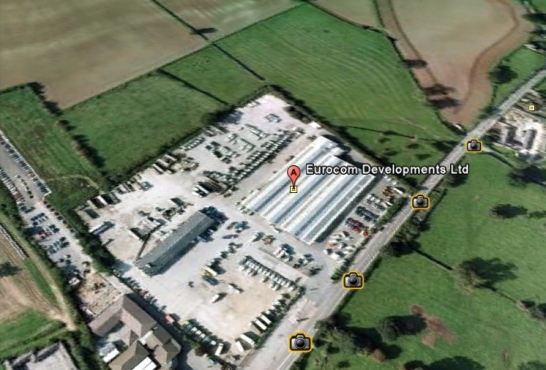
Ashbourne Road, Mackworth, Derby, DE22 4NB (Image source: Google Earth)
Eurocom was based in England. The “U.K.” could possibly refer back to its headquarters.

Below the label, you can almost make out some of the words from the partly erased magic marker writing: GT INTERACTIVE / DUKE / NUKEM.
This Duke Nukem 64 prototype came from a European game development collector by the name of Simon Band. I attempted to learn more about its background history, but as of this writing I have not been able to reach him, so how he secured the item remains a mystery.
Band runs GBADev.org, a resource for Game Boy Advance development information. On that site, he used to maintain a section that was dedicated to his own personal collection of prototype hardware, and other rare oddities, but those pages now rest in a virtual graveyard of dead links. Digging through the rubble, I found two photographs of this Duke Nukem 64 cartridge from 2007, and two more of another PAL Nintendo 64 prototype taken that same year: id Software’s QUAKE. Both prototypes share a few commonalities. They are housed in the same type of development cartridge, they have a similar heavily weathered front label, and QUAKE was also distributed by Duke Nukem 64‘s publisher, GT Interactive, in Europe. The QUAKE prototype is dated February 25, 1998, which is roughly a month before its U.S. release (link).
I was also able to ascertain that Band had purchased assets directly from game companies in the past, including Compile and Athena, which allowed him to acquire such items as even more Nintendo 64 flash development cartridges and Nintendo 64DD blue disks containing the unreleased expansion to Dezaemon 3D, a Japanese shooting game maker (link, link, link).
He additionally once owned Toon Panic, a cancelled Nintendo 64 fighting title that surfaced on Yahoo! Japan Auctions and was later leaked by a prolific console release group that calls itself “Team CARROT” (link).
Before we get to the nitty-gritty, I want to make sure that I give proper kudos to a hacker extraordinaire by the name of “Zoinkity,” who not only assisted me during the trying dumping process, but also dedicated a serious amount of time and effort in thoroughly tearing apart and helping me document the prototype binary afterwards, going so far as to reverse-engineer the game to convert the Duke Nukem 64 maps over to the PC.
 |
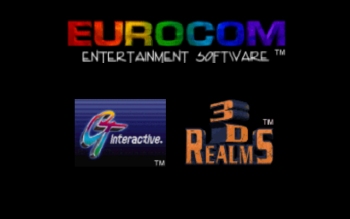 |
During the game’s startup, there is a difference in the fade timers for the legal and splash screens, which results in the prototype taking slightly longer to get to the title screen.
The next change can be found on the title screen itself. The retail game uses a different set of button codes to activate the cheats, depending upon its region. For example, pressing the following buttons on the title screen in the PAL retail version would enable these cheats:
Activate Cheats: Left, Down, L, L, Up, Right, Left, Up
All Cheats: Up-C, Up, Left-C, Right, Down-C, Down, Right-C, R All Items: R, Right-C, Down, L, Up-C, Left, Right-C, Left
God Mode: R, Right-C, R, L, R, R, R, Left
Level Select: R, L, R, Down-C, Right, Up, Left, Up-C
No Monsters: L, Up-C, Left, L, Down-C, Right, Left, Right
This being a PAL prototype, you would think they would work here, too, but that’s not the case. Instead, the prototype actually uses the cheat code inputs from the North American retail version:
Activate Cheats: Left, Left, L, L, Right, Right, Left, Left
All Cheats: Up, Up-C, Left, Right-C, Down, Down-C, Right, Left-C
God Mode: R, R, R, R, R, R, R, Left
Level Select: L, L, L, Right-C, Right, Left, Left, Left-C
No Monsters: L, Left-C, Left, R, Right-C, Right, Left, Left
 |
 |
|
|
|
There’s a textual difference in the Control Options menu: “Control Pad” appears in the prototype rather than “Controller.”
 |
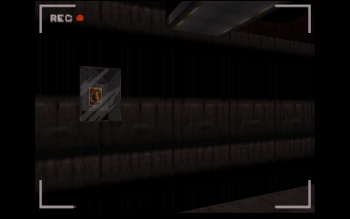 |
|
|
|
 |
 |
|
|
|
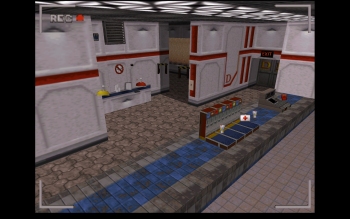 |
 |
|
|
|
 |
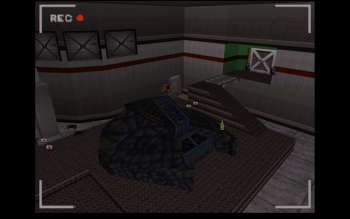 |
|
|
|
 |
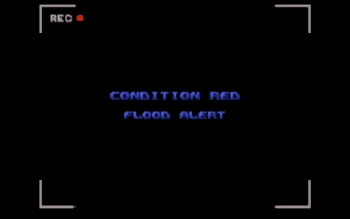 |
|
|
|
 |
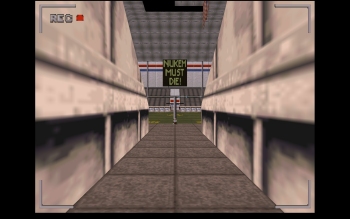 |
|
|
|
The security camera footage was shot from a higher vantage point in the prototype.
According to “Zoinkity,” “They changed the camera from a simple X/Z projection to a full X/Y/Z projection. About the only noticeable results are the CCTV feeds, though. The prototype sets a single multiplier value, which changes the angle the camera is at. It’s really a Y rotation, but the end result is that it pushes the viewport up or down. The camera itself is really just an X/Z view, and Y is fixed, and this sets the angle up or down. Retail doesn’t need a value. It creates this nifty X/Y/Z projection matrix based on the detected game region even though this is only able to run on PAL. Y is a real value, and I’m pretty sure this is why the CCTV has a different field of view.”
An IGN preview video of the in-game surveillance system from July 29, 1997 showed the security camera’s perspective as being the same as the final release (link).
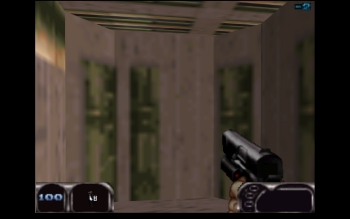 |
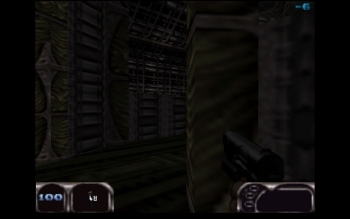 |
|
|
|
A multiplayer spawn point, which is referred to in BUILD as an “APLAYER” sprite, has been moved in Fusion Station. This affects where a player or a Dukebot starts out on the map during Dukematch mode.
 |
|
|
The above image is an overhead view of the map in the PC version. The prototype-only APLAYER sprite is the yellow circle on the left, and the PAL retail’s APLAYER sprite is the one on the right.
 |
|
|
The APLAYER sprite that is unique to the prototype can be found in the elevator near the beginning of the level, just past the two Turrets.
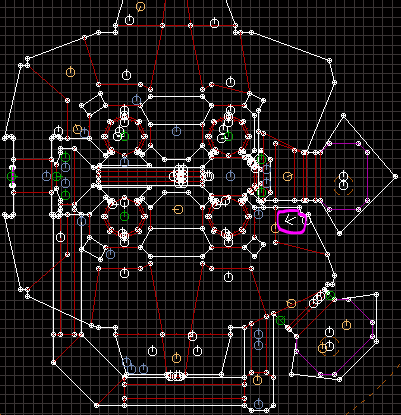 |
|
|
The retail version doesn’t have an APLAYER sprite there because it was carried over to the end of the room with the rising and falling pillars.
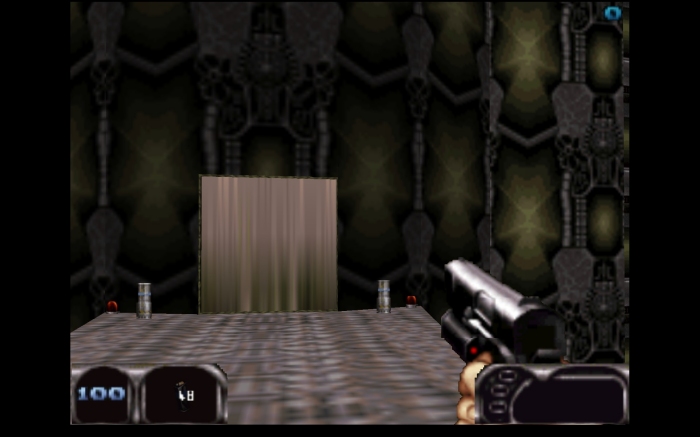 |
|
|
In the prototype, when a human or a computer-controlled player spawns at the elevator’s APLAYER sprite, the elevator will begin to descend indefinitely until its wall textures stretch.
 |
|
|
Eventually, the elevator’s wall graphics will disappear into a completely black background, which can be seen through by other players on the outside.
|
|
|
|
The player inside, however, will become trapped in the elevator, unable to escape for the remainder of the match.
 |
 |
|
|
|
Finally, Eurocom used an older controller library in the prototype. The retail version’s later update adds in a repair function and better support for reading, writing, and detecting peripherals, particularly the Controller Pak.
A note about the back-up file: In addition to its laundry list of flaws like poor build quality and general unreliability, the GameShark Pro also has a nasty habit of throwing out overdumps, and this Duke Nukem 64 prototype was no exception, with the saved ROM image being twice the size that it should be, or 16 megabytes. I’ve always been of the mind that overdumps equal bad dumps, but in the case of the GameShark Pro, outputting excess data is apparently a perfectly normal and accepted thing.
Verifying that the non-mirrored data was good entailed making multiple back-ups using a patched version of the official GameShark Pro Utilities program to ensure that each bloated ROM image matched. They did, but that still didn’t leave me with a ton of confidence knowing that development history like this is in the hands of a cheap cheat code device from the 1990s.
As “Zoinkity” pointed out to me, and I was able to independently confirm, 0x800000-0xBFE000 from the overdump mirrored all the data from 0x402000-0x800000 and added 0x2000 bytes set to 0xFF. 0xC00000-0xFFE000 mirrored all the data from 0x802000-0xC00000 and added 0x2000 bytes set to 0xFF.
In short, the original verified prototype overdump has been trimmed of its fat and safely resized down to the 8 megabyte file that you can find linked to down below.










